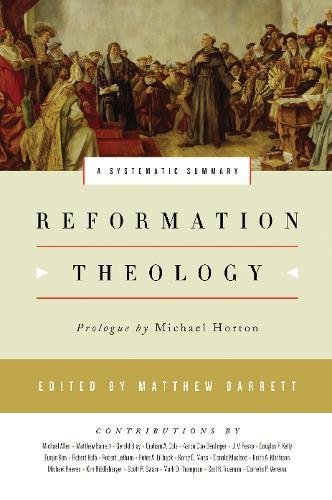A Brief Book Summary from Books At a Glance (Part 2)
By Steve West
Introduction
Reformation Theology: A Systematic Summary is a collection of essays by distinguished scholars on important themes in the theology of the Reformers. The essays cover a variety of essential theological topics, explaining both the agreements and disagreements amongst the Reformers and their schools. Each subject is treated with an eye to historical and theological accuracy, as well as to the importance and relevance of each topic.
This Summary (Part 2) covers chapters 11-20.
Table of Contents
Prologue: Michael Horton
Chapter 1 The Crux of Genuine Reform
Chapter 2 Late-Medieval Theology
Chapter 3 The Reformers and Their Reformations
Chapter 4 Sola Scriptura
Chapter 5 The Holy Trinity
Chapter 6 The Being and Attributes of God
Chapter 7 Predestination and Election
Chapter 8 Creation, Mankind, and the Image of God
Chapter 9 The Person of Christ
Chapter 10 The Work of Christ
Chapter 11 The Holy Spirit
Chapter 12 Union with Christ
Chapter 13 The Bondage and Liberation of the Will
Chapter 14 Justification by Faith Alone
Chapter 15 Sanctification, Perseverance, and Assurance
Chapter 16 The Church
Chapter 17 Baptism
Chapter 18 The Lord’s Supper
Chapter 19 The Relationship of Church and State
Chapter 20 Eschatology
Summary (Part 2)
Chapter 11: The Holy Spirit
Graham A. Cole
The Reformers believed in the Trinity, and thus in the personhood and deity of the Holy Spirit. This belief was affirmed by the four magisterial Reformers (Luther, Zwingli, Calvin, and Cranmer) and the one radical Reformer (Simons) that will be discussed in this chapter. Luther held that the Spirit worked through God’s Word and the sacraments; he rejected extra-Scriptural revelation by the Spirit. For Luther, Christ’s objective work had to be revealed and applied by the Spirit in order for people to be saved. The church depended on the Spirit for its life. Zwingli held that the Word of God was especially the Spirit’s Word. He believed that the Spirit was the one who gave people spiritual life, assurance of salvation, and was necessary for spiritual growth. Calvin is often identified as the premier Reformed theologian in pneumatology. Like Luther and Zwingli, Calvin drew the tightest connection between the Word and the Spirit. It is the Spirit who works inside of people to convince them that the Scripture is the Word of God. The Spirit works in the sacraments to confirm and increase faith. Producing faith is the work of the Spirit, as is the vital task of uniting us with Christ so that we can saved. Cranmer is not considered a great theologian compared to some other magisterial Reformers, but he had significant theological acumen, and he was able to produce the Prayer Book which has shaped and informed the thinking and practice of millions of Christians. For Cranmer, the Scriptures were the tool the Spirit used to save and instruct people of all classes. The Spirit regenerates the elect and works in them for their sanctification, helping them produce good works. Christ is with his people in this age through the Spirit. Menno Simons was a key figure in the Anabaptist movement, but he wasn’t their best theologian. For Simons, the Scripture was the norming norm. He did not claim to have revelations in the Spirit like some others did. The Spirit regenerated and then filled believers. A church is a pure company of believers—baptism is the entry and the ban controls removal and exit. It is the Spirit who incorporates people into the church and the Spirit who removes them through the application of the ban. Although there are obvious differences between the magisterial and radical reformers, their basic pneumatology was the same.
Chapter 12: Union with Christ
J. V. Fesko
The NT is replete with references to being in Christ, and this was recognized before the time of the Reformers. Medieval theologians looked to the hypostatic union as the grounds for humanity being in God, and also saw union with Christ as a key element of soteriology. Unlike Rome, Luther saw justification as coming only by the alien righteousness of Christ, and this righteousness was ours by virtue of union with him. Out of this union, sanctification and good works flowed. Melanchthon taught that union was based on Christ’s indwelling the believer. He explained that the legal ground of justification was Christ’s imputed righteousness rather than the fact that Christ indwelt believers. Calvin maintained that union with Christ brought the twin graces of justification and sanctification. As important as union with Christ was for Calvin’s theology, he did not elaborate on the doctrine very much; he assumed it. Vermigli discussed union with Christ as natural, spiritual, and mystical, and taught that union is central from justification through glorification. Calvin, answering opponents, was clear that our nature is not mixed with Christ’s in our union together.
Today, the doctrine of union with Christ is usually reserved for discussions of soteriology, but for the Reformers it was also part of wider Christology and other topics (like the sacraments). For the Reformers, the sacraments were a means of being strengthened in Christ. Believers communed with Christ through the sacraments by virtue of their union with him. Preaching and the sacraments were the means the Spirit used to. . .
[To continue reading this summary, please see below....]The remainder of this article is premium content. Become a member to continue reading.
Already have an account? Sign In
